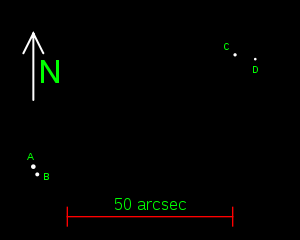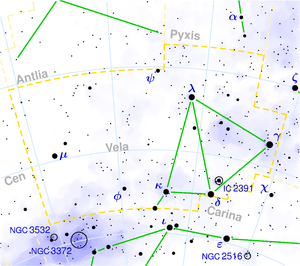- Delta Velorum
-
Doppelstern
Delta Velorum
Die Komponenten von Delta Velorum Beobachtungsdaten
Äquinoktium: J2000.0, Epoche: J2000.0Sternbild Segel des Schiffs Rektaszension 08h 44m 42,23s [1] Deklination -54° 42′ 31,8″ [1] Scheinbare Helligkeit 1,93 mag [1] Typisierung Spektralklasse A1 V [1] U−B-Farbindex +0,07 [2] B−V-Farbindex +0,04 [2] R−I-Index +0,02 [2] Astrometrie Radialgeschwindigkeit (2,2 ± 2) km/s Parallaxe (40,49 ± 0,39) mas [3] Entfernung [3] (80,55 ± 0,78) Lj
(24,70 ± 0,24) pcVisuelle Absolute Helligkeit Mvis -0,03 mag [Anm 1] Eigenbewegung [3] Rek.-Anteil: (28,99 ± 0,50) mas/a Dekl.-Anteil: (-103,35 ± 0,54) mas/a Physikalische Eigenschaften Leuchtkraft Andere Bezeichnungen
und KatalogeinträgeBayer-Bezeichnung δ Velorum Córdoba-Durchmusterung CD -54° 2351 Henry-Draper-Katalog HD 74956 [1] Hipparcos-Katalog HIP 42913 [2] Bright-Star-Katalog HR 3485 [3] SAO-Katalog SAO 236232 [4] Weitere Bezeichnungen CCDM J08448-5442 ABCD Aladin previewer Anmerkung - ↑ Aus Scheinbarer Helligkeit und Entfernung errechnet.
Delta Velorum ist ein Sternsystem im Sternbild Segel des Schiffs. Es ist ungefähr 80 Lichtjahre von der Erde entfernt. Das System besteht aus zwei Doppelsternen. Der hellste der vier Sterne, Delta Velorum A, ist ein weißer Hauptreihenstern mit einer Helligkeit von +2 mag. Sein binärer Begleiter Delta Velorum B, hat eine Helligkeit von ca 5 mag und liegt von Komponente A 2,6 Bogensekunden entfernt. Das zweite binäre System ist 69 Bogensekunden entfernt. Es besteht aus dem Stern 11. Größe Delta Velorum C und dem Stern 13. Größe Delta Velorum D, die einen Abstand von 6 Bogensekunden voneinander haben.
Komponenten Rektaszension Deklination vis. Helligkeit (mag) Referenz-
punktEntfernung vom
Ref.-Punkt
(arcsec)Richtung vom
Ref.-PunktA 08h 44m 42.2s −54° 42′ 30″ 2,1 B 08h 44m 42.2s −54° 42′ 28″ 5,1 A 2,6 153° C 08h 44m 48.9s −54° 41′ 46″ 11,0 A 69.2 61° D 08h 44m 49.6s −54° 41′ 48″ 13,5 C 6.2 102° Einzelnachweise
Kategorien:- Individueller Stern zweiter Größe
- Doppelstern
- Segel des Schiffs
- Gelber Zwerg
Wikimedia Foundation.

